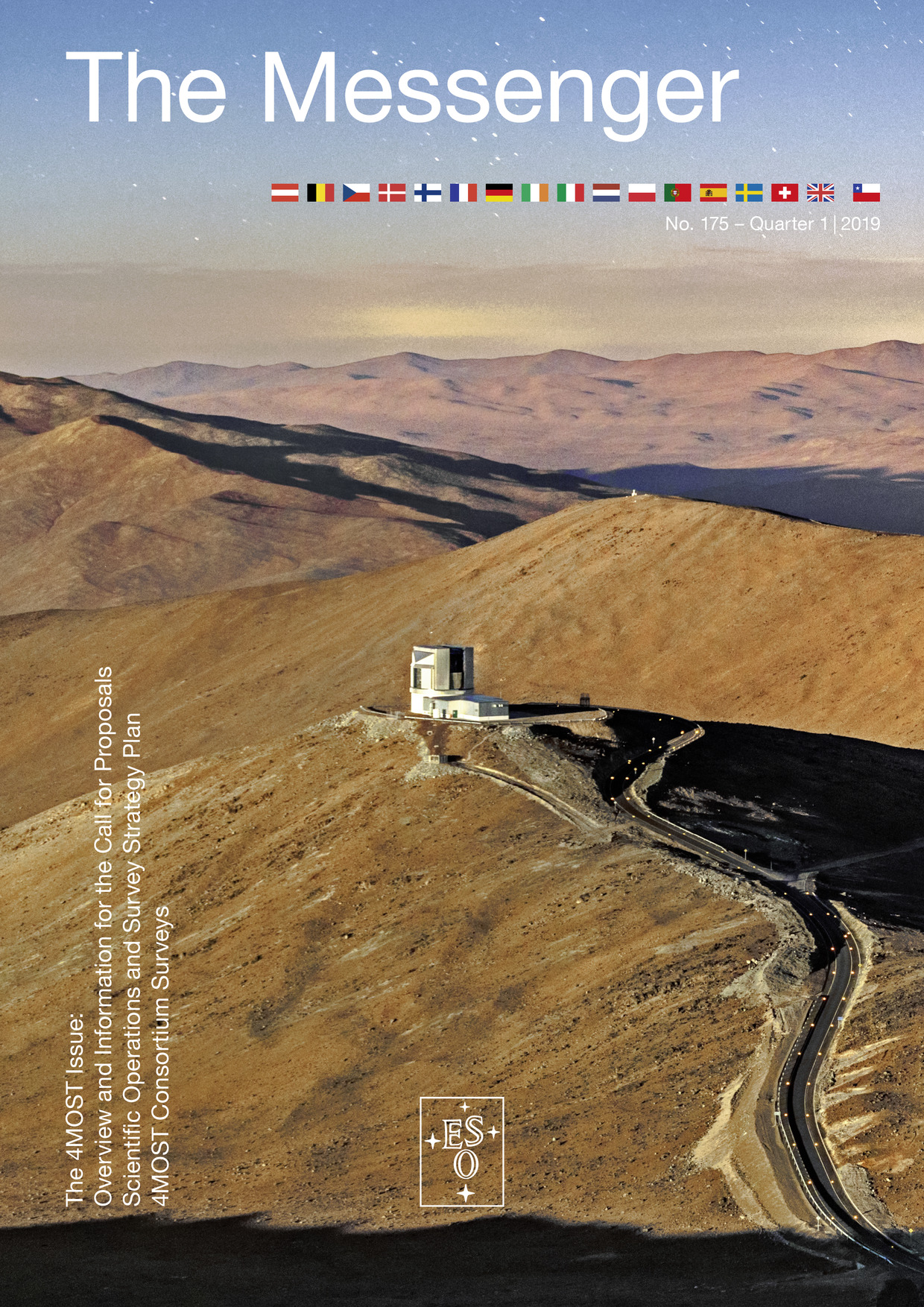de Jong, R., Agertz, O. et al.
Authors:
de Jong, R., Agertz, O., Berbel, A., Aird, J., Alexander, D., Amarsi, A., Anders, F., Andrae, R., Ansarinejad, B., Ansorge, W., Antilogus, P., Anwand-Heerwart, H., Arentsen, A., Arnadottir, A., Asplund, M., Auger, M., Azais, N., Baade, D., Baker, G., Baker, S., Balbinot, E., Baldry, I., Banerji, M., Barden, S., Barklem, P., Barthélémy-Mazot, E., Battistini, C., Bauer, S., Bell, C., Bellido-Tirado, O., Bellstedt, S., Belokurov, V., Bensby, T., Bergemann, M., Bestenlehner, J., Bielby, R., Bilicki, M., Blake, C., Bland-Hawthorn, J., Boeche, C., Boland, W., Boller, T., Bongard, S., Bongiorno, A., Bonifacio, P., Boudon, D., Brooks, D., Brown, M., Brown, R., Brüggen, M., Brynnel, J., Brzeski, J., Buchert, T., Buschkamp, P., Caffau, E., Caillier, P., Carrick, J., Casagrande, L., Case, S., Casey, A., Cesarini, I., Cescutti, G., Chapuis, D., Chiappini, C., Childress, M., Christlieb, N., Church, R., Cioni, M., Cluver, M., Colless, M., Collett, T., Comparat, J., Cooper, A., Couch, W., Courbin, F., Croom, S., Croton, D., Daguisé, E., Dalton, G., Davies, L., Davis, T., de Laverny, P., Deason, A., Dionies, F., Disseau, K., Doel, P., Döscher, D., Driver, S., Dwelly, T., Eckert, D., Edge, A., Edvardsson, B., Youssoufi, D., Elhaddad, A., Enke, H., Erfanianfar, G., Farrell, T., Fechner, T., Feiz, C., Feltzing, S., Ferreras, I., Feuerstein, D., Feuillet, D., Finoguenov, A., Ford, D., Fotopoulou, S., Fouesneau, M., Frenk, C., Frey, S., Gaessler, W., Geier, S., Fusillo, N., Gerhard, O., Giannantonio, T., Giannone, D., Gibson, B., Gillingham, P., González-Fernández, C., Gonzalez-Solares, E., Gottloeber, S., Gould, A., Grebel, E., Gueguen, A., Guiglion, G., Haehnelt, M., Hahn, T., Hansen, C., Hartman, H., Hauptner, K., Hawkins, K., Haynes, D., Haynes, R., Heiter, U., Helmi, A., Aguayo, C., Hewett, P., Hinton, S., Hobbs, D., Hoenig, S., Hofman, D., Hook, I., Hopgood, J., Hopkins, A., Hourihane, A., Howes, L., Howlett, C., Huet, T., Irwin, M., Iwert, O., Jablonka, P., Jahn, T., Jahnke, K., Jarno, A., Jin, S., Jofre, P., Johl, D., Jones, D., Jönsson, H., Jordan, C., Karovicova, I., Khalatyan, A., Kelz, A., Kennicutt, R., King, D., Kitaura, F., Klar, J., Klauser, U., Kneib, J., Koch, A., Koposov, S., Kordopatis, G., Korn, A., Kosmalski, J., Kotak, R., Kovalev, M., Kreckel, K., Kripak, Y., Krumpe, M., Kuijken, K., Kunder, A., Kushniruk, I., Lam, M., Lamer, G., Laurent, F., Lawrence, J., Lehmitz, M., Lemasle, B., Lewis, J., Li, B., Lidman, C., Lind, K., Liske, J., Lizon, J., Loveday, J., Ludwig, H., McDermid, R., Maguire, K., Mainieri, V., Mali, S., Mandel, H., Mandel, K., Mannering, L., Martell, S., Martinez Delgado, D., Matijevic, G., McGregor, H., McMahon, R., McMillan, P., Mena, O., Merloni, A., Meyer, M., Michel, C., Micheva, G., Migniau, J., Minchev, I., Monari, G., Muller, R., Murphy, D., Muthukrishna, D., Nandra, K., Navarro, R., Ness, M., Nichani, V., Nichol, R., Nicklas, H., Niederhofer, F., Norberg, P., Obreschkow, D., Oliver, S., Owers, M., Pai, N., Pankratow, S., Parkinson, D., Paschke, J., Paterson, R., Pecontal, A., Parry, I., Phillips, D., Pillepich, A., Pinard, L., Pirard, J., Piskunov, N., Plank, V., Plüschke, D., Pons, E., Popesso, P., Power, C., Pragt, J., Pramskiy, A., Pryer, D., Quattri, M., de Andrade Queiroz, A., Quirrenbach, A., Rahurkar, S., Raichoor, A., Ramstedt, S., Rau, A., Recio-Blanco, A., Reiss, R., Renaud, F., Revaz, Y., Rhode, P., Richard, J., Richter, A., Rix, H., Robotham, A., Roelfsema, R., Romaniello, M., Rosario, D., Rothmaier, F., Roukema, B., Ruchti, G., Rupprecht, G., Rybizki, J., Ryde, N., Saar, A., Sadler, E., Sahlén, M., Salvato, M., Sassolas, B., Saunders, W., Saviauk, A., Sbordone, L., Schmidt, T., Schnurr, O., Scholz, R., Schwope, A., Seifert, W., Shanks, T., Sheinis, A., Sivov, T., Skúladóttir, Á., Smartt, S., Smedley, S., Smith, G., Smith, R., Sorce, J., Spitler, L., Starkenburg, E., Steinmetz, M., Stilz, I., Storm, J., Sullivan, M., Sutherland, W., Swann, E., Tamone, A., Taylor, E., Teillon, J., Tempel, E., ter Horst, R., Thi, W., Tolstoy, E., Trager, S., Traven, G., Tremblay, P., Tresse, L., Valentini, M., van de Weygaert, R., van den Ancker, M., Veljanoski, J., Venkatesan, S., Wagner, L., Wagner, K., Walcher, C., Waller, L., Walton, N., Wang, L., Winkler, R., Wisotzki, L., Worley, C., Worseck, G., Xiang, M., Xu, W., Yong, D., Zhao, C., Zheng, J., Zscheyge, F., Zucker, D.
Abstract:
We introduce the 4-metre Multi-Object Spectroscopic Telescope (4MOST), a new high-multiplex, wide-field spectroscopic survey facility under development for the four-metre-class Visible and Infrared Survey Telescope for Astronomy (VISTA) at Paranal. Its key specifications are: a large field of view (FoV) of 4.2 square degrees and a high multiplex capability, with 1624 fibres feeding two low-resolution spectrographs (R = λ/Δλ ~ 6500), and 812 fibres transferring light to the high-resolution spectrograph (R ~ 20 000). After a description of the instrument and its expected performance, a short overview is given of its operational scheme and planned 4MOST Consortium science; these aspects are covered in more detail in other articles in this edition of The Messenger. Finally, the processes, schedules, and policies concerning the selection of ESO Community Surveys are presented, commencing with a singular opportunity to submit Letters of Intent for Public Surveys during the first five years of 4MOST operations.


